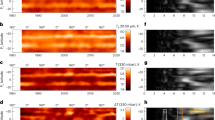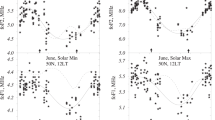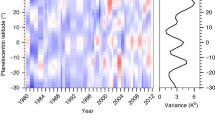Abstract
KING-HELE1 has reported a semi-annual variation in thermospheric density at about 190 km with a maximum to minimum ratio of 1.45. Cook's hypothesis2 that the semi-annual variation is caused by the modulation of the helium content of the lower thermosphere, originally coined to account for the variation at 1,100 km, clearly cannot be applied to explain changes at 190 km. The reconciliation between theory and observation is in essentially the same state as it was a year ago. There is the hypothesis of Anderson3 that the semi-annual variation results from a migration of the perigee points of the satellites studied with latitude in such a manner that the drag at perigee is small when over the winter pole which is supposed to be cold (and of lower density than the equatorial regions). Debate is continuing about Anderson's hypothesis4,5 and no doubt the issue can be resolved when sufficient values of density for a wide range of perigee latitudes and over all seasons are available, such as the simultaneous changes at 190 and 1,100 km. Anderson quotes as support my colleagues' computations6, which show a cold winter pole. The influence of motions, however, was neglected in these computations and it has recently been shown that the influence of vertical motions is quite substantial (ref. 7 and unpublished work of R. E. Dickinson, C. P. Lagos and R. E. Newell). Satellite drag observations by Jacchia8 and Keating and Prior9 show higher densities over the winter pole than over the summer pole. Jacchia and Slowey10 could reduce—but not eliminate—the effect by manipulating parameters in their model; indeed, the effect was predicted before observation11 and seems to increase with altitude as expected from theory.
This is a preview of subscription content, access via your institution
Access options
Subscribe to this journal
Receive 51 print issues and online access
$199.00 per year
only $3.90 per issue
Buy this article
- Purchase on Springer Link
- Instant access to full article PDF
Prices may be subject to local taxes which are calculated during checkout
Similar content being viewed by others
References
King-Hele, D. G., Nature, 216, 880 (1967).
Cook, G. E., Planet. Space Sci., 15, 627 (1967).
Anderson, A. D., Planet. Space Sci., 14, 849 (1966).
King-Hele, D. G., Planet. Space Sci., 14, 863 (1966).
Anderson, A. D. LMSC–6–77–67–40 (Lockheed Missiles and Space Company, Palo Alto, California, 1967).
Lagos, C. P., and Mahoney, J. R., J. Atmos. Sci., 24, 88 (1967).
Lagos, C. P., MIT, Dept. of Meteorology, Rep. No. 20, 134 (1967).
Jacchia, L. G., Smithsonian Astrophys. Obs. Spec. Rep., No. 184 (1965).
Keating, G. M., and Prior, E. J., Space Res., VII, 1119 (North-Holland Publishing Co., Amsterdam, 1967).
Jacchia, L. G., and Slowey, J., Space Res., VII, 1077 (North-Holland Publishing Co., Amsterdam, 1967).
Newell, R. E., Problems of Atmospheric Circulation (edit. by Garcia, R. V. and Malone, T. F.), 106 (Spartan Books, Washington, 1966).
Chandra, S., and Krishnamarthy, B. V., Planet. Space Sci. (in the press).
Jacchia, L. G., Space Res., V, 1152 (North-Holland Publishing Co., Amsterdam, 1965).
Kantor, A. J., and Cole, A. E., J. App. Meteor., 4, 228 (1965).
Cole, K. D., Space Sci. Rev., 5, 699 (1966).
Newell, R. E., Nature, 211, 700 (1966).
Matsushita, S., and Maeda, H., J. Geophys. Res., 70, 2535 (1965).
Greenhow, J. S., and Neufeld, E. L., Quart. J. Roy. Meteor. Soc., 87, 472 (1961).
Newell, R. E., and Dickinson, R. E., Pure and Applied Geophysics (in the press).
Jacchia, L. G., Slowey, L., and Verani, F., J. Geophys. Res., 72, 1423 (1967).
King-Hele, D. G., and Quinn, E., Planet. Space Sci., 14, 1023 (1966).
Author information
Authors and Affiliations
Rights and permissions
About this article
Cite this article
NEWELL, R. Semi-annual Variation in Thermospheric Density. Nature 217, 150–151 (1968). https://doi.org/10.1038/217150a0
Received:
Published:
Issue Date:
DOI: https://doi.org/10.1038/217150a0
This article is cited by
-
Semi-annual Variation in Upper Atmosphere Density
Nature (1968)
-
Charge-transfer Interactions between Solar Wind Protons and Neutral Particles in the Vicinity of the Sun
Nature (1968)
-
Neutral corpuscular energy flux by charge-transfer collisions in the vicinity of the sun
Astrophysics and Space Science (1968)
Comments
By submitting a comment you agree to abide by our Terms and Community Guidelines. If you find something abusive or that does not comply with our terms or guidelines please flag it as inappropriate.



